Introduction: Healthy Frozen Meals:
In today’s fast-paced world, frozen meals have become a lifesaver for busy individuals. However, not all frozen meals are created equal. While some are loaded with sodium, preservatives, and unhealthy fats, others are carefully crafted to provide balanced nutrition. This guide will help you navigate the frozen food aisle, offering tips to select healthy frozen meals that are both convenient and nourishing.
Why Choose Frozen Meals?
Frozen meals can be a great addition to your meal plan for several reasons:
- Convenience: Ready in minutes, they save time on meal prep and cooking.
- Portion Control: Pre-portioned meals help prevent overeating.
- Reduced Food Waste: Frozen meals last longer, reducing the risk of spoilage.
The key is to select options that align with your nutritional goals while avoiding hidden unhealthy ingredients.
What to Look for in Healthy Frozen Meals
To ensure you’re making the healthiest choice, keep the following criteria in mind:
- Nutritional Balance: Look for meals that include a balance of lean protein, whole grains, and vegetables. A well-rounded meal should contain:
- 15–25 grams of protein
- At least 5 grams of fiber
- Healthy fats from sources like olive oil, nuts, or seeds
- Low Sodium: Many frozen meals are high in sodium for preservation. Aim for meals with less than 600 milligrams of sodium per serving.
- Minimal Added Sugars: Check the ingredient list for hidden sugars like corn syrup or dextrose. Ideally, stick to meals with less than 5 grams of added sugar.
- Whole Ingredients: Choose meals with recognizable, whole-food ingredients. Avoid artificial additives, preservatives, and food colorings.
- Calorie Count: Depending on your dietary needs, look for meals with 300–500 calories per serving.
Tips for Shopping in the Frozen Aisle
Here are some practical tips to make healthier choices while shopping:
- Read the Labels: Flip the box and check the nutrition facts and ingredient list. The fewer, the better!
- Choose International Cuisines: Meals inspired by global cuisines like Mediterranean, Thai, or Indian often have a variety of vegetables and spices, making them flavorful and nutritious.
- Go for Plant-Based Options: Plant-based frozen meals are often lower in saturated fat and higher in fiber. Look for meals containing legumes, tofu, or quinoa.
- Avoid Creamy Sauces: Opt for meals with tomato-based or broth-based sauces instead of creamy or cheesy alternatives, which tend to be high in fat and calories.
Best Healthy Frozen Meal Brands
Here are some top-rated brands that prioritize health and quality:
- Amy’s Kitchen: Known for organic, vegetarian-friendly, and allergen-free options.
- Evol: Offers meals made with high-quality, non-GMO ingredients.
- Healthy Choice: Provides balanced meals with lean proteins and vegetables.
- Saffron Road: Specializes in globally-inspired, protein-rich frozen meals.
- Kashi: Focuses on whole grains and plant-based ingredients.
Quick DIY Healthy Frozen Meals
If you prefer a more customized approach, consider making your own frozen meals at home. Prepare large batches of healthy dishes like soups, stir-fries, or casseroles, and freeze them in individual portion sizes. This way, you control the ingredients and nutritional content.
Conclusion
Frozen meals don’t have to be unhealthy! With careful selection and attention to nutrition labels, you can enjoy the convenience of frozen food without compromising your health. Whether you’re shopping for a quick lunch or a ready-made dinner, follow these tips to make informed and nutritious choices.
By prioritizing balanced meals with whole ingredients, you’ll turn frozen food into a healthy ally in your busy lifestyle.
Let me know if you’d like additional tips or recipe ideas!
For more, visit our website, Homethreads






